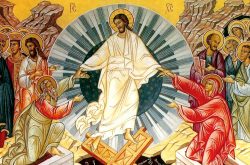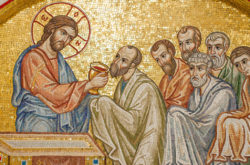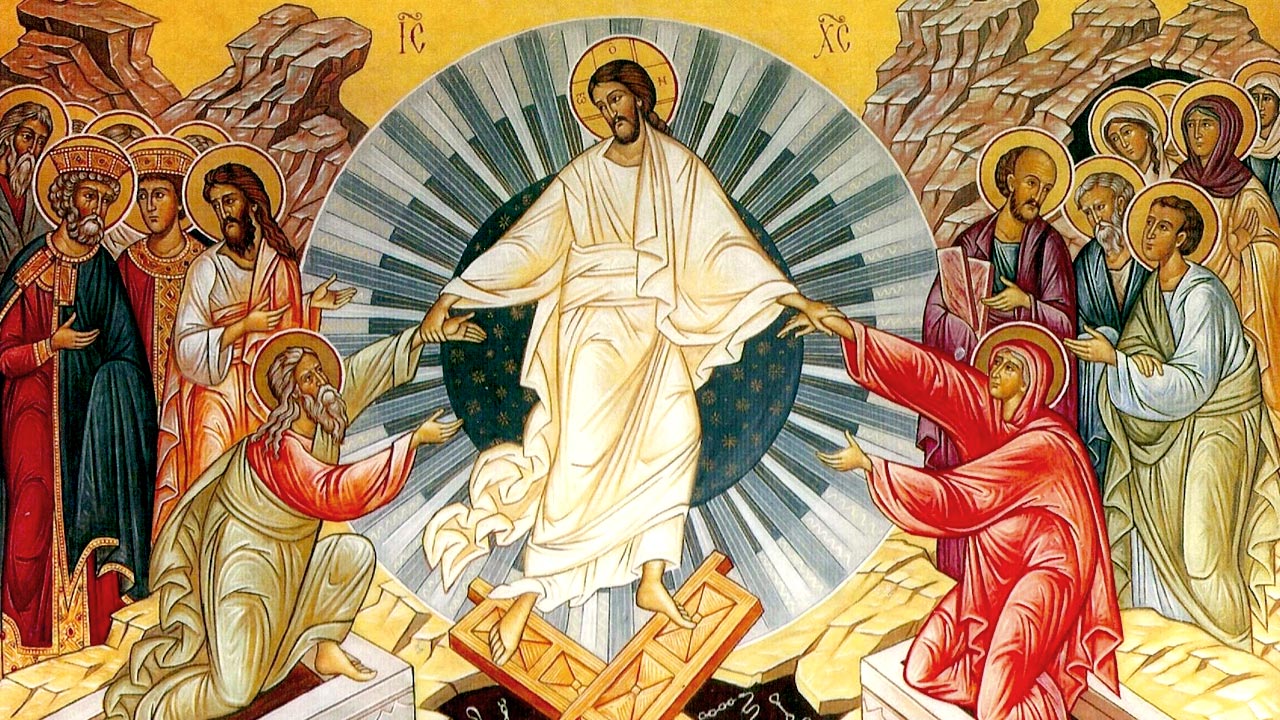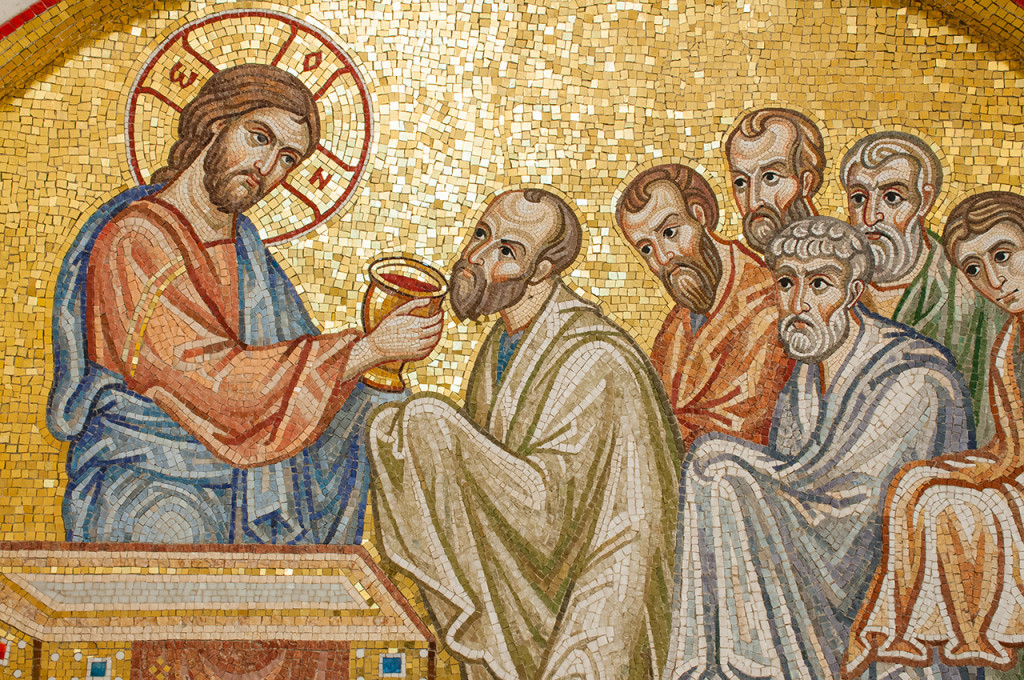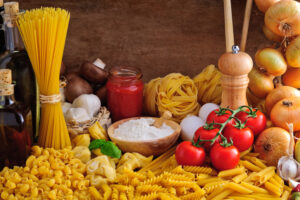How to restore ourselves as icons of God 我們如何回復如神的形像
John 約翰福音 1:43-51 New King James Version (NKJV)
2013.3.24 sermon by Father Jonah
今日是正教會的聖日,我們要一同慶祝正教會的勝利,紀念(反聖像畫運動的失敗和)「聖像畫的復興」。今日也是「大齋期」開始後的第一個星期日,為了迎接耶穌基督的復活,我們可以利用這段時間做好靈性上的準備。為了迎接耶穌基督的復活,教會為我們提供了不同階段的準備工作。(上週日,我們進行了第一階段,)今天我們要進行第二階段:我們要謹記在心,沒有真正的、正確的信仰,就沒有真正的靈修生活。這就是為什麼教會今天要特別提醒我們正確信仰的重要性。
「Orthodox」代表的意義是:用正確的方式(ortho)榮耀上帝(doxa)。好好瞭解「Orthodox」的真義,對我們每日的靈修生活非常重要。基督徒並不是靠外在知識來過生活。我的意思是,我們不需要像數學家、物理學家或是醫學家那樣,一方面要研讀知識、創造科學理論,一方面又要想著如何過生活。我們完全可以把信仰與生活結合在一起:信仰可以拯救我們的生命,我們可以用生命來詮釋信仰。
在此,我想要與各位談談教會的歷史。公元843年之後聖像畫終於得到復興,但在這之前的一百五十年間,歷代皇帝和一些教會人士(他們當中有許多位已經被逐出教會)反對人們對聖像畫敬禮,他們甚至主張廢除聖像畫。為什麼會有這樣的誤解?其中一個原因是,歷代皇帝受到東方穆斯林的宗教與文化的影響,他們認為不應該為神塑造任何形象。另一個原因是,許多基督徒濫用聖像畫,引起了眾人的反感。因此,當時許多聖像畫被摧毀。儘管,第七次大公會議已經給予聖像畫新的定義,還是產生了許多爭議,直到公元843年這些爭議才得到平息,我們今日讀到的文獻,就是當時流傳下來的。
讓我們一起來瞭解聖像畫的一些歷史。從舊約的內容,我們可以得知當時已經有聖像的存在。例如:上帝要摩西用黃金為基路伯在施恩座(約櫃)的兩頭塑像(出25:17-20)。教會史學家指出,在新約中曾經提到一位患有血漏的婦女,得到耶穌的醫治之後,為了表達心中的感謝,就在她的門外為耶穌造了一個雕像,她還跪在雕像前面向耶穌致敬。之後,皇帝Julian摧毀了這個雕像,並且在同一個地點樹立了自己的雕像。結果,這個雕像被天上降下的閃電摧毀。
除此之外,還有人獻給敘利亞國王Abgar一塊印有耶穌基督的面容的布料,那是聖徒Veronica的手巾。耶穌被捕的時候,Veronica拿了一條手巾幫耶穌把臉上的汗水、污漬擦掉,並且安慰耶穌,而耶穌的面容,也印在這條手巾上面。可見,聖像是教會活生生的傳統。在希臘、羅馬…等地的地下墓穴中,也曾出現過聖像。宗徒路加就是一位聖像畫家。牆上的這幅聖像「黑色聖母」(Black Madonna)是教會珍貴的傳統之一,十字軍偷走了這幅畫,現在它被收藏在波蘭。傳統上我們認為它的作者就是宗徒路加,它的色調如此黑暗是因為年代久遠的關係。
「聖像」是用色彩(而非文字)來表達神學。它必須有許多層底色(許多層背景光),就像祭壇後面的這些聖像畫一樣。它呈現出一種透明感,它是一種非常神聖的藝術。不是每個人都能畫聖像,聖像畫家必須經常祈禱和靈修。聖像並非肖像,許多聖像畫家藉由繪製聖像而變得非常屬靈。這幅描繪「聖三」的聖像的作者Andrei Rublev是一位聖徒,還有其它許多美麗的聖像的作者,也都成為聖徒。他們皆能善用色彩,表達出神學的奧秘。
由上文可知,聖像已經存在教會許久,然而,有些異端人士產生誤解:他們偏離教會的道路,想要與教會分離。如果有人認為教會當中有些事情需要改進,他們應該將這些事情向主教報告,或是在會議上提出。然而,這些人直接攻擊教會、抹黑教會的人,並且私自拿走、摧毀聖像,還做了許多破壞的行為。耶穌基督在最後的祈禱中說:「讓我們合一,就像聖三一樣。」我們應該團結一心,異端分子只想分裂教會。教會並非政黨,我們不該用對立的方式來溝通。教會是耶穌基督的身體。
讓我們看看異端份子(例如:Balaam,他反對Gregory Palmas的學說),無論在君士坦丁堡或阿陀斯聖山,他們從來不領聖餐。他們錯誤的信仰和不領聖餐形成了惡性循環。讓我們看看那些因為反聖像而被逐出教會的異端份子、主教或修士,他們和統治者掛勾,逮捕了修院的院長和主教們。這就是為什麼,當我們唸到他們的名字時,我們說他們已經死了。他們用燒紅的鐵在他們的額頭上烙印。這些人也從來不向上帝告解,就算他們告解,也只說一些謊話,或者說一些無關緊要的事情,而隱藏重要的事情。他們欺瞞上帝,一步步走向異端的道路。
我們應該對正教的信仰有正確的理解。這就是為什麼我用許多方式來解釋我們的信仰。因為,信仰並不是教條,也不是書本上的神學而已,信仰是真心的禮拜。如果我們擁有錯誤的信仰,也會有錯誤的人生,如果我們擁有罪惡的人生,我們也很難擁有正確的信仰。
教會正式的名稱並非「正教會」,而是「唯一的、大公的、宗徒傳下來的教會」。這也是信經的內容。那麼,「Orthodoxy」代表了什麼意義?它就是耶穌基督所說的:「我願他們合一,就像我們這樣。」合一的信仰,就是正教會的信仰。
我們要如何合一?上帝的兒子成為人,並且賜給我們他的身體,藉由教會的聖事,我們進入耶穌體內,在耶穌體內合一。今日的聖禮儀(聖徒Basil的版本)是多麼美妙的儀式,聖徒Basil寫下了:「在耶穌基督體內合而為一,在我們每一位當中合而為一。」這是多麼美妙的文字。這就是聖三位一體的奧秘。我們的聖三,是合一的、至高的。真正的自由就是愛,就是合一與共存。如果沒有愛,就沒有真正的自由。
在上文中,我們一起瞭解了「Orthodoxy」的意義。「Orthodoxy」的真義,就是合一,在耶穌基督體內成為一體,領受聖餐,參與聖禮儀。這就是正教的精神,聖像、香和聖袍所代表的意義,也都是由此出發。
無論我們在哪裡,或許是在家獨自祈禱,或許是在其他地方,甚至是深山或荒野中的隱修士,他們都不是獨自一人,他們是教會的一份子。我們應該以此精神來生活,我們在教會中合一,我們是正教徒。
人都會犯錯。但是,故意犯錯和無心犯錯並不相同。這就是為什麼我們需要告解,而教會可以寬恕我們的罪。透過告解與悔改,每一個星期日,我們都在上帝的愛中成長。
上帝的愛並非情緒性的。上帝是愛,因為上帝是三位一體。上帝希望我們都明白祂就是愛,而不是至高的權柄。只有魔鬼才會把上帝當作是恐怖的法官,而不是愛。
單純地說:「我信上帝。」並不是真正的信仰。在上帝的愛中合一,才是正教會的信仰。我們應該在教會的聖事中、在領聖餐的時候認識真正的上帝,祂是聖三位一體。我們用誠心彼此相待,因為,我們每個人都是上帝的聖像。這也是「聖像復興」真正的意義。我們應該要像懷抱嬰兒一樣,把聖像擁抱在懷裡。因為,我們每個人都擁有聖徒的特質,聖徒、主耶穌基督和他神聖的母親,與你變得十分親近,這就是為什麼我們需要聖像(雙手交叉放在胸前),它們就像是我們的孩子一樣珍貴。有一位皇后為了保護聖像,將它們藏了起來。當皇帝問起的時候,她說,我需要聖像,就像孩子需要洋娃娃一樣。
從公元843年至今,聖像不再受到反對。然而,我們真正的聖像,我們真正的面容,現在已經生病了,我們用各種方式損害了它,誰要來幫我們找回這原本的容貌,讓我們重新成為上帝的聖像?這就是教父提醒我們的課題。我們原是上帝的聖像,我們應該要潔身自愛,好好保護它。我們是教會最美麗的聖像,因為我們就是上帝活生生的聖像,擁有上帝的面容。我們應該牢記這一點。
我想要給你們一面鏡子,當你們重新返回上帝的容貌時,就能看見自己的樣子。我們每個人都是上帝神聖的肖像,我們應該尊重、珍惜這幅美麗的聖像。
我非常欣賞日本人,他們無論身在哪裡,都會不斷鞠躬,表現出謙恭的禮儀,這就好像我們在耶穌基督的聖像前面也會不斷鞠躬、表達敬意。我們應該彼此尊敬,因為我們每個人的體內都有耶穌基督。聖經告訴我們,我們的身體是上帝的聖殿。
今日,讓我們謹記在心,我們都是上帝的聖像。讓我們拿一面鏡子好好看看自己,向自己鞠躬敬禮,也向其他人表達敬意。當你看到別人的時候,就像看到耶穌基督一樣,好好向他們鞠躬致敬。隱居在荒漠中的神聖教父曾說:「你見到自己的兄弟,要像見到上帝那樣。」我們可以在靈修生活中實踐這樣的精神,讓自己這幅受損的聖像能夠修復成原本的樣子。讓我們成為上帝的聖像並且散發光芒。讓我們與耶穌基督合一,正如他教導我們的「讓我們所有人合而為一」。
願聖三守護我們。阿門。
John 1:43 The following day Jesus wanted to go to Galilee, and He found Philip and said to him, “Follow Me.” 44 Now Philip was from Bethsaida, the city of Andrew and Peter. 45 Philip found Nathanael and said to him, “We have found Him of whom Moses in the law, and also the prophets, wrote—Jesus of Nazareth, the son of Joseph.”
46 And Nathanael said to him, “Can anything good come out of Nazareth?”
Philip said to him, “Come and see.”
47 Jesus saw Nathanael coming toward Him, and said of him, “Behold, an Israelite indeed, in whom is no deceit!”
48 Nathanael said to Him, “How do You know me?”
Jesus answered and said to him, “Before Philip called you, when you were under the fig tree, I saw you.”
49 Nathanael answered and said to Him, “Rabbi, You are the Son of God! You are the King of Israel!”
50 Jesus answered and said to him, “Because I said to you, ‘I saw you under the fig tree,’ do you believe? You will see greater things than these.” 51 And He said to him, “Most assuredly, I say to you, hereafter you shall see heaven open, and the angels of God ascending and descending upon the Son of Man.”
Today you saw that we celebrated the restoration of the icons, the Sunday of Orthodoxy. As we saw from last week, the Great Lent is a period to prepare us spiritually to accept and be ready for the Resurrection of Jesus Christ. And the Church has different steps for this preparation. Last week the Church taught us that without forgiveness there is no meaning for the spiritual life. And today the Church tells us the second step: that without the true faith, without the right faith, there is also not spiritual life. And this is why the church reminds us today about the correct faith.
Because “Orthodox” means to glorify God (doxa) in the right way (ortho). And if we don’t believe correctly, this also affects our everyday spiritual life. The Christian is not an intellectual Christian. He is not like a mathematician, for example, or a physicist, or even a doctor who can have his own theoretical ideas while his life is different. But our life and our faith is one thing: our faith saves our life; our life expresses our faith.
And for the history, I will start here to say that what we read today, because it is a longer text, it has more anathemas, and it started to be read in the Church from 843, when the icons were restored in the churches. Because, as you know there was a big controversy against the icons for about 150 years by the emperors, and some of the people of the church (you hear some of their names in the anathemas). This misunderstanding was because the emperors who were influenced, from one point of view, by the Muslims – coming from the East to the West – who did not like any kind of image. And from the other point of view, because many Christians over-used the icons, using them in the wrong way and scandalizing many people. So many of the icons were destroyed. We had the Seventh Ecumenical Council, which gave the meaning of icons, but even after this we had a lot of conflicts. All of this finally ended in 843, and from that time today, the Church reads this text.
Just to say a few things historically about the icons. There are have icons even in the old Testament, for example God told Moses to make the golden cherubim on the Ark of the Covenant. And we see in the New Testament that the historians of the Church said that the woman who Jesus cured from the bleeding, in gratitude made a statue of Jesus Christ outside of her house and she was kneeling in front of this. Then Julian the emperor destroyed this statue of Jesus Christ and he put his own statue there, but thunder came from heaven and destroyed the statue. We have also the cloth with the face of Jesus that was sent to the king of Syria, Abgar, with his face. We also have the cloth of SaintVeronica, the woman who put a cloth to Jesus face when he was being carried, to comfort him and the image of His face was stamped on it. This is the living tradition of the church, how we paint the face of Jesus Christ. We also have icons in the catacombs; we see a lot in Greece and Rome and other places we have drawings. And Luke the apostle was an icon painter. We have icons in Greece painted by Luke the apostle, even this Black Madonna there (pointing to one on the wall), which is the tradition of the Church, although it was stolen by the Crusaders and now it is in Poland now. The tradition says it was painted by Luke the apostle and it is black because of its age.
Icons are theology in colors, not in words, but in colors. An icon is made by different layers of light, as you can see here (pointing to icons over the altar). It is transparent and it is a very holy art. It is not for everybody to make icons, you must pray and do a lot of things. And the icons are not portraits; there is a very holy way to make icons and we have icon painters who, through the painting of icons, become holy. And we have many, especially the most beautiful of the icons, the Holy Trinity by Andrei Rublev, who became a saint by using the mystery and the mastery of color to express theology.
We have all these things, but we see now what happened to the heretics, who misunderstood the Church, even made mistakes with the Church. And this is a point that we stress about faith today: they separated from the Church, they did not follow the way of the Church. And the Church way is if you see something you think is wrong, you go to the bishop or to the Council, the Church of course has a procedure. So what did they do? They split the Church; they created their own churches, splitting and scandalizing the people of the Church, and then they took icons and threw them away, they did a lot of things. People died for this, and this was the big sin, to create a scandal and split the church. Jesus Christ came and he said, “I want you to become a father,” in his last prayer, John 17, the prayer of the high priest, he said, “To become one, as the Trinity is one.” We should become one, but the heretics split this thing, this unity of the church. And this splitting also created for them a big lie, because the Church is not a political party where you can split a political party to make an opposition, like we have in everyday politics or in business. But the Church is the Body of Jesus Christ.
And you see the heretics, if you see the life of the heretics, for example Balaam, who was against Gregory Palmas, they never saw him receive the Holy Communion in Constantinople or Mount Athos. So you see how his wrong faith influenced him, and because of not receiving the Holy Communion, he had the wrong faith and it became a cycle. If you see the Anathemas and the bishops and the monks who were against the icons, they were conspiring with the emperor to arrest other abbots and bishops. This is why when we read their names we say they died; they had their foreheads branded with hot iron like slaves. So living a life of conspiracy, living a life of lies, living a life of “Can we do this,” or, “We will do this. We will make something here. We will destroy the icons there. And we will make a church without icons here.” These people, of course they were not confessing, or even if they were confessing, they were saying lies. Because when confessing, you know, you do not confess to me, you confess to God. If you tell a small thing but you hide a big thing, for example, if you say, “Yes, I told lies to my mother when I was a kid,” and you hide that you conspired to destroy the church, this is a big thing, right? You tell the small thing and you hide the big thing. The priest is not an investigator, he must accept whatever you say in front of God, and if you cheat, you cheat God. And, yes, those people who cheated God in their confession, and they mocked God, of course they became gradually heretics.
You must understand the Orthodox faith, once more I say. And this is why I prepared some applications for mobiles and IPads some simple and abstract explanations of the Orthodox faith. We don’t say, this is dogmatics, we say, the worshipping faith; because It is never like when somebody is studying dogmatics, something for the theologians. It’s not about the theologians; if we have wrong faith we have wrong life, and if we have sinful life we have wrong faith.
So somebody will say, “And finally, what is this all for?” The official name of our Church is not “Orthodox,” our church’s official name is “The One, Catholic and Apostolic Church,” right? This is what we say in the Creed. This is the faith of the Apostles as we read today; this is the faith of the saints; this is the faith of the Catholic Church. We are the Catholic Church. What is Orthodoxy? I will say to you, it’s not the candles and the icons and all this; I will say to you very simply – it is what Jesus Christ said, “Father, I want them to be one as we are one.” This becoming one, this is the Orthodox faith.
But how to become one? Not under a king, not under a chief, but in an unbelievable way, a way that even the angels could not imagine. The Son of God became human, and he gave his body so that when we come here we enter his body through the sacraments of the Church, with different ways you and me, but we unite ourselves and feed ourselves. And as today in the liturgy of Saint Basil, which is such a beautiful liturgy, we saw that he says, “To become one, one in Jesus Christ, and one in everybody of us.” This mystery is the mystery of the Trinity. This why we say, “Where is another God like our God?” And we say it so beautifully, because we don’t compare gods, but you see the Holy Trinity, the Communion and the ultimate. The Orthodox Church says that freedom is not making a contract for your freedom, but freedom is love, freedom is coexistence. And if there is no love, there is no freedom.
So we see what Orthodoxy is all about. And only if you have this idea of Orthodoxy, the communion with each other, the unity with each other to become one in the Body of Jesus Christ, taking this Body and participating in the Liturgy even if you don’t receive the Holy Communion. This is the Orthodox Church. And if you have this then the icons make sense, then the incense makes sense, then these clothes (pointing to his robes) they make sense, everything makes sense. If we don’t have this, we are not Orthodox. You can be named whatever you want. I can be named the Pope of Rome; I’m not, so what?
And it is very important to understand that an Orthodox – even if he is in his house, even when he prays alone – he is never alone: he is a part of the Body of the Church. Even the ascetic, the monk who lives in a cave in the mountains, he does not pray as an individual: he prays for the Body of the Church and he prays as a member of the Body of the Church. He is never alone. He is like this hand, one finger here, one finger here, one finger here. So this is Orthodoxy. If we have this idea, if we have this way of life, the unity in the community, in the Church, we are Orthodox. If we don’t have this we can be many other things but we are not Orthodox. And yes, this is why the Church reminds us today: without the correct dogmatic life, forget about spirituality, your spirituality is not fulfilled, it is missing, it is something sick.
And yes we will do sins because of human weakness. It is different to do sins because of human weakness, as I do – more than you, and to do sins on purpose and hiding, on purpose to destroy something, to destroy you, to destroy the Church of God. It is different to do a sin because, well, I’m angry or my mind it cannot be so big. This is why the Church has confession, this is why the Church gives forgiveness. And then we will see next Sunday and the Sunday after that, the different steps to go through confession and to improve in the love of God.
God is love because God is Trinity. God has no love as an emotion, but he is love because of his existence and the way he exists. And he wants us to know him as love, not as power, as the demons know him very well – but they know him as power, not as love.
And this is Orthodoxy. This is the knowledge of God from the Orthodox. It is not to say, “Do you believe in God?” “Yes, of course I believe.” That is not the Orthodox faith. To know God is to know him, as I say, as Trinity, and in the Holy Communion and in the Sacraments of the Church. And today I gaze at you and you gaze at me, eye to eye, honestly. And why do I say honestly? Because we see the icon of God today. And this is the meaning of restoring the icons. I told you to hold the icons in you: it’s like holding babies on your bosoms. Because you have the saints on you, so close, and because the saints become so familiar to you, and the Lord Jesus Christ and His Holy Mother, this is how we must have the icons (crossing hands over his chest) just like our kids.
The emperess who restored the icons, she was hiding the icons from her husband, and he said to her, “What are you doing? What are you hiding here?” She said to him, it’s like the kids who have dolls. And I could give you another kind of title, and I will explain to you later. But who will restore? So today we must remember that we must not only restore the icons – the icons have already been restored in the Orthodox churches from 843. But who will restore these icons, our icons, my face and your faces, that are sick, dirty – because they are icons of God. And each one of us, by different ways, has polluted, has scratched, and has destroyed it. There are specialists who can restore an old icon. But where are the specialists who can restore our own icons? Because we are images of God. And this is what the Fathers of the Church want us to remember today. We are images of god and whatever we do that is bad, we scratch this holy icon of God. And we must restore it because, yes, we have these icons. The most beautiful icons in the church are you because you are the living images of God; we are the living images of God. And we should not forget this.
And this is why I would like to give you a mirror when you return the icons so you could see yourself, to see each of us, as a holy icon of God, to see – each one of us – how to restore this icon of God, and how to respect each other as an icon of God.
Many times I have told you how I admire the Japanese people because they bow everywhere (bowing repeatedly), and this is very deep because just as we bow in front of the icon of our Lord Jesus Christ we should bow in front of you, and you should bow to each other because Jesus is inside your body, you are the temple of God. The Bible says this, right? Our body is the living temple of God; this (pointing to the altar) is not, this is just stones and plastic and glass and any kind of materials we use. And you see the Holy Communion I will not throw to a holy place, I will throw in your mouths and in my mouth.
So, remember this today: you are the icons. Later take a mirror and see yourselves; bow to yourself, bow to the others, see our brothers everywhere, and when you see them you see Jesus Christ and bow to him. The Fathers of the Desert say, “Did you see your brother? You saw your God.” And when we do this, then really we can go on and we can carry on in the spiritual life, restoring and polishing and making the icon of God that we are to shine, and to become one with Jesus Christ, as he said, “All to become one.”
May the Holy Trinity protect all of us. Amen.
